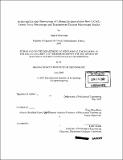In-situ and ex-situ observations of lithium de-intercalation from LiCoO₂ : atomic force microscopy and transmission electron microscopy studies
Author(s)
Clémençon, Anne
DownloadFull printable version (7.954Mb)
Other Contributors
Massachusetts Institute of Technology. Dept. of Mechanical Engineering.
Advisor
Yang Shao-Horn.
Terms of use
Metadata
Show full item recordAbstract
Lithium cobalt dioxide is the most commonly used material for positive electrodes in lithium rechargeable batteries. During lithium de-intercalation from this material, ... undergoes a number of phase transitions, which have been studied by bulk techniques and first-principles calculations. The objective of this work was to examine the effect of charge and discharge on individual LiC₀O₂ crystals. Atomic Force Microscopy and Transmission Electron Microscopy were used to observe the effects of lithium ion de-intercalation from ... in individual crystals. This work was the first study to use in-situ Atomic Force Microscopy to probe the dynamic evolution of ... crystal morphology as lithium ions are de-intercalated from the material. The overall crystal morphology did not seem to evolve very much during the first charge and discharge cycle however evidence was found for expansion and contraction of crystal steps during cycling. The evolution of layer spacing was quantified from AFM data and was found to be in agreement with X-ray diffraction studies by other researchers. Furthermore, rounded bumps were observed on the surface of most of the crystals, and it is speculated that these bumps are Li₂CO₃ impurities, formed on the surface of LiC₀O₂ after storage in air. Lastly, the formation of a surface layer on ... crystals and the gold foil substrate was observed when the cell was over-discharged to approximately 2.5V. Transmission Electron Microscopy was used to image individual LixCoO2 crystals for different values of lithium concentration in the range corresponding to the insulator-metal phase transition. (cont.) Electron diffraction patterns revealed the presence of lithium-vacancy ordering in charged ... samples. In parallel, Electrochemical Impedance Spectroscopy and X-ray Diffraction were used to characterize the evolution of the electronic and structural properties of ... during the phase transition. EIS data showed that the electronic resistivity of ... decreased by three orders of magnitude at the onset of charge, in agreement with literature. XRD data from charged ... samples showed an increase in layer spacing, also in good agreement with previous studies done by other researchers.
Description
Thesis (S.M.)--Massachusetts Institute of Technology, Dept. of Mechanical Engineering, 2005. Includes bibliographical references (p. 106-108).
Date issued
2005Department
Massachusetts Institute of Technology. Department of Mechanical EngineeringPublisher
Massachusetts Institute of Technology
Keywords
Mechanical Engineering.